Brief
In relatively short order, the proliferation of unconventional gas has altered the North American energy landscape. Now, coupled with substantial major new gas discoveries elsewhere, it is shifting energy dynamics across the globe. North American natural gas prices now hover between $2/MMBtu and $2.50/MMBtu, down from highs in the $10/MMBtu to $13/MMBtu range just a few years ago—thanks to the low cost of extraction and sheer abundance of shale gas. The “Shale Gale” has turned North America into a “gas island” that is no longer dependent on gas imports, forcing LNG once destined for US shores to find new markets. This new supply—combined with other trends, such as the emerging potential of shale gas in China, Latin America and portions of Europe; the discovery of large gas resources in Australia and Africa; and the Fukushima disaster—has added tremendous uncertainty to the global energy picture.
Energy players in every region now face new questions about shale and other indigenous gas sources, imported LNG, pipeline-imported sources of gas supply and the historical pricing patterns and relationships across all three. Will the dynamics of shale gas in the US cascade across the world and affect Europe and Asia-Pacific? Will we see a truly global market for gas, with prices linked across the major market regions of Asia, Europe and North America? In light of regional resource variations and market trends, what is the right portfolio balance across different geographies and between existing and unproved assets? Additionally, the need for new infrastructure and other changes across the value chain raises more questions for energy companies, including whether to build LNG and midstream infrastructure and whether to expand marketing and trading activities. And related to this, how should joint ventures (JVs) be used to gain access to resources and skills or move across the value chain?
Exploration and production players operating in the US face additional dilemmas, including how to adapt their production processes to deliver shale gas cost-effectively in a saturated near-term market while developing competitive advantage for the longer term. They will also need to understand how policy decisions—particularly whether and how much gas will be permitted to be exported—will affect the demand for and price of natural gas and their implications for investment levels.
In North America, the abundance of shale gas has caused several dramatic effects. Given current consumption levels, North America will not require pipelined gas from Alaska, Canada or anywhere else until the next century. Focus in the US has shifted from importing gas to exporting it—and the fervor is building. The Federal Energy Regulatory Commission (FERC) reported that, as of March 2012, five facility operators in North America have proposed gas export facilities and another six have identified sites with the potential to export.
But whether US shale gas finds its way into the LNG market in any meaningful quantity remains a big question. One way for the US to absorb increasing gas supplies is to spur domestic demand by replacing thermal coal generation with gas-fired generation. If current emission constraints are strictly enforced or strengthened or a carbon tax is established and levied against power producers, it would accelerate the rate at which gas displaces coal, the largest single source of fuel for power generation today. Other opportunities to increase domestic gas usage include promoting natural gas vehicles or gas-to-liquids conversion methods for producing diesel fuel.
A closely related issue is how the oil and gas industry can create stable supply and rational pricing models that encourage long-term investment by industrial users of gas, including petrochemicals, steel and cement producers. For producers, that would require a move away from the current pricing of gas as a by-product to higher pricing levels in the range of $5/MMBtu to $6/MMBtu. This would enable economical drilling for dry gas, creating a more stable supply and encouraging a fundamental change in US industrial gas consumption. For that to happen, several policy uncertainties would need to be addressed in the US, most important, whether and to what degree the Department of Energy and FERC will allow exports of natural gas. Another important policy question is whether the government will offer support or subsidies for gas-powered vehicles and gas-to-liquids conversion technologies or stimulate other “new demand” markets.
New supplies for Europe
In Europe, demand for gas from unconventional sources continues to accelerate, driven by the depletion of conventional gas, ongoing environmental concerns and the Fukushima disaster’s impact on the role of nuclear power. All of these factors have made gas an increasingly important energy source.
Historically, Europe’s supply has come from a combination of LNG imports, UK and Norwegian continental shelves, other indigenous gas sources and long-haul pipeline gas imports from Russia. Now, in addition to new LNG supplies (including supplies that had been destined for North America) and more gas from Russia, a new supply option has emerged: local unconventional gas. Several countries, notably Poland and Germany, are moving quickly to tap their indigenous shale gas.
All these new supplies create alternatives to traditional LNG imports and long-haul pipeline gas from Russia. Competition has increased dramatically, and pressure to decrease prices is mounting. For example, Centrica recently signed a contract with Qatar based on the UK’s wholesale gas price (NBP). Several major buyers in Europe followed suit, leading to contracts whose terms included more spot gas prices than were typical for the region. That resulted in overall price reductions of as much as 20% off traditional oil-indexed pricing.
However, Europe faces several important challenges to developing its shale industry that are not found in North America, including significantly less oilfield service and equipment infrastructure, deeper and less homogenous shale resources and greater land access issues due to population density. European governments are also generally less familiar with shale gas extraction and do not have well-developed regulation policies to address it. Some countries, including those with high potential for shale gas, are not yet comfortable with the environmental impact on water, air and land of shale activity. France, for instance, has placed a moratorium on development. Despite these challenges, European LNG and piped-gas prices—historically linked to oil—are showing a slow shift to a gas-on-gas pricing model.
The gas battleground: Asia-Pacific
Asia-Pacific is becoming the new global battleground for gas suppliers around the world. We expect demand to grow substantially beyond the traditional buyers of Japan, Korea and Taiwan. Growth will come primarily from China and India as well as other rapidly growing Asian economies, such as Thailand, Singapore, Vietnam and the Philippines.
Currently, supply to the region comes from a combination of local conventional, pipeline, LNG imports and limited unconventional sources, mostly coal-bed methane (CBM). New gas supplies from West Africa, the Middle East and Australia also are arriving in Asia (see Figure 1). Asia could even import LNG from North America, though that would depend on several factors. Among them: whether the US would allow exports from either the contiguous 48 states or Alaska, whether Asian buyers would be comfortable relying on new contract structures tied to liquefaction rights only (versus equity gas ownership) and, of course, the relative cost of gas, including transportation and other logistics between North America’s west coast, the Gulf Coast, Australia, Africa and elsewhere. Asia also contains a number of potential wildcards—including China’s ability to generate its own gas supply from its indigenous shale, CBM and other sources, and how rapidly Japan will shift its fuel mix and current emphasis on supply security. Given these supply and demand uncertainties, we see three distinct scenarios for the future of gas in Asia-Pacific (see Figure 2).
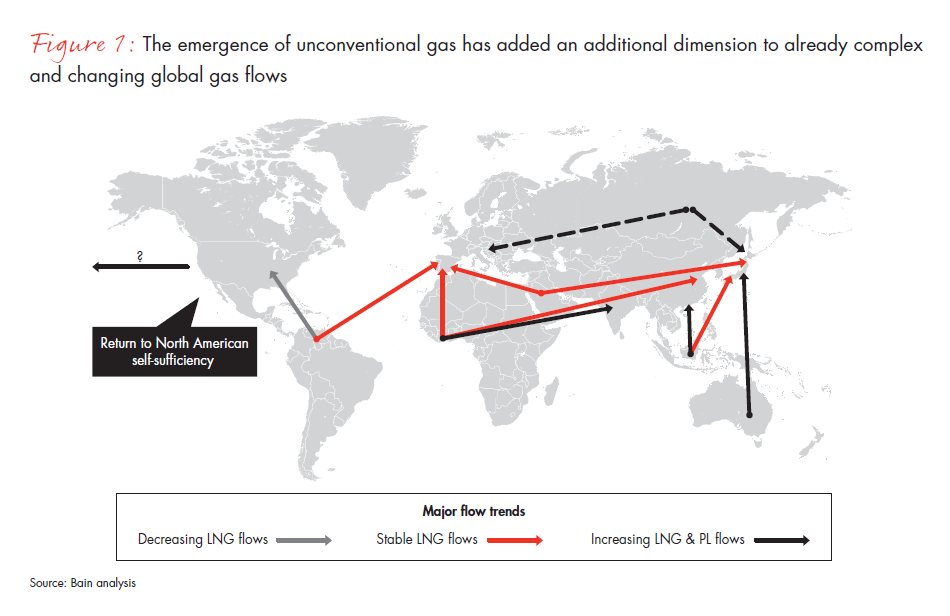
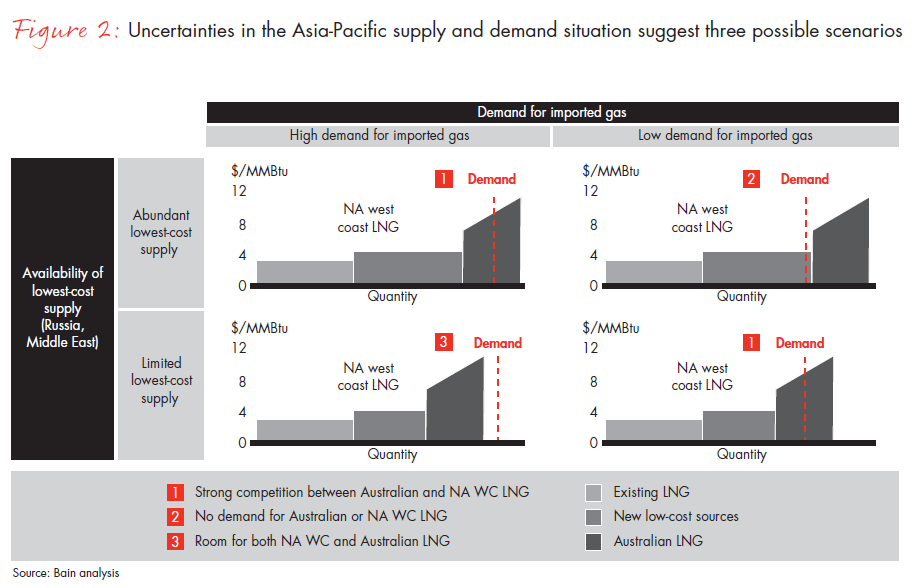
Generally, these factors are facilitating a shift away from current LNG oil-indexed pricing trends toward gas-on-gas pricing—even though the temporary spike in demand from Japan after the Fukushima disaster may have delayed that shift.
How global energy markets develop
So what is the future of natural gas markets around the world? The history of other commodity markets, such as refined products and coal, suggests that the gas market will also globalize and evolve from a model where contracts (especially in Asia and Europe) are generally indexed to oil prices to one based on gas-on-gas pricing (see Figure 3). In other commodity markets, the emergence of many different players and multiple crossborder flows rapidly led to a globally competitive market. As LNG trade flows move from local, bilateral arrangements to cross-regional, multiple-party participation, we expect a similar progression.
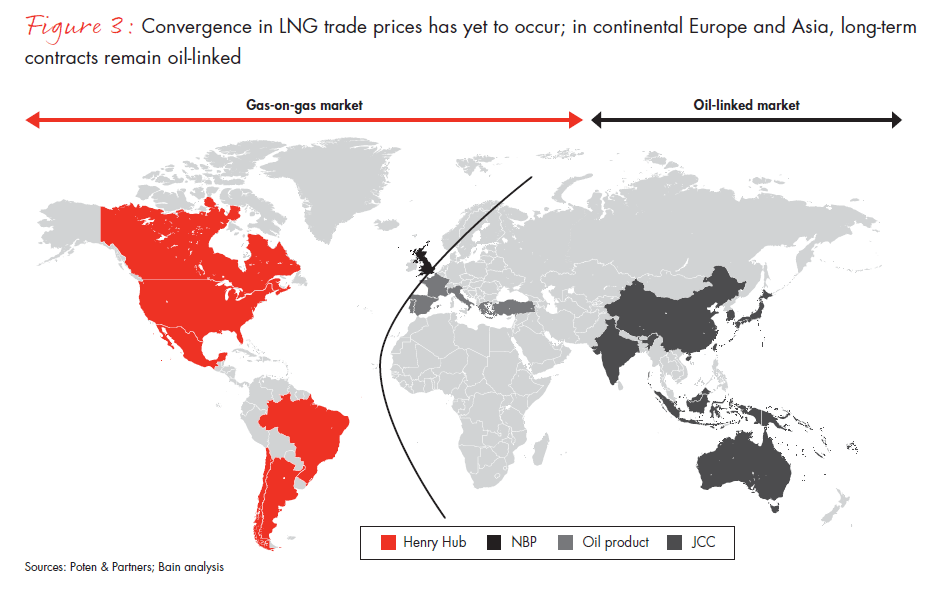
Take, for example, the development of the global seaborne coal market. As volumes of seaborne coal have grown, financial liquidity has followed. In general, more liquid markets tend to have lower levels of producer concentration. Predictably the market share of the top four producers of seaborne coal decreased from approximately one-half of the market in 2001 to one-third in 2008. In comparison, today the top four producers of LNG comprise about half of the market. If LNG follows seaborne coal’s pace of change, we should expect to see a more diversified and fragmented set of LNG suppliers in the next decade.
As the financial markets for coal developed, so did the necessary seaborne coal infrastructure of ever larger and deeper ports and better transport systems comprised of railways, river barges and trucks. LNG is now following a similar path. Investments in pipelines and conventional gas infrastructure have accelerated, as illustrated by the development of key pipelines linking China to gas fields in Myanmar, Kazakhstan and Russia. A plethora of re-gas terminals around the globe have also emerged. And new technology developments, including floating liquefied natural gas (FLNG), mini- LNG and floating re-gas capability, further aid LNG infrastructure development.
In addition to greater liquidity and better infrastructure, higher volumes of coal also helped create more sophisticated financial instruments, allowing nontraditional players to get involved with coal and regular buyers and suppliers to hedge their positions. In the 1990s, growth in the coal spot market, along with tender sales, boomed. In 2006, globalCOAL started futures trading (see Figure 4). Currently, the seaborne trade indices in Asia, Europe and North America move in tandem as the coal trading market continues to grow. LNG appears to be following a similar pattern. Traditionally, LNG trade was primarily regional and achieved through long-term contracts. But over the last 20 years, it has evolved from a bilateral to a more international market-based model.
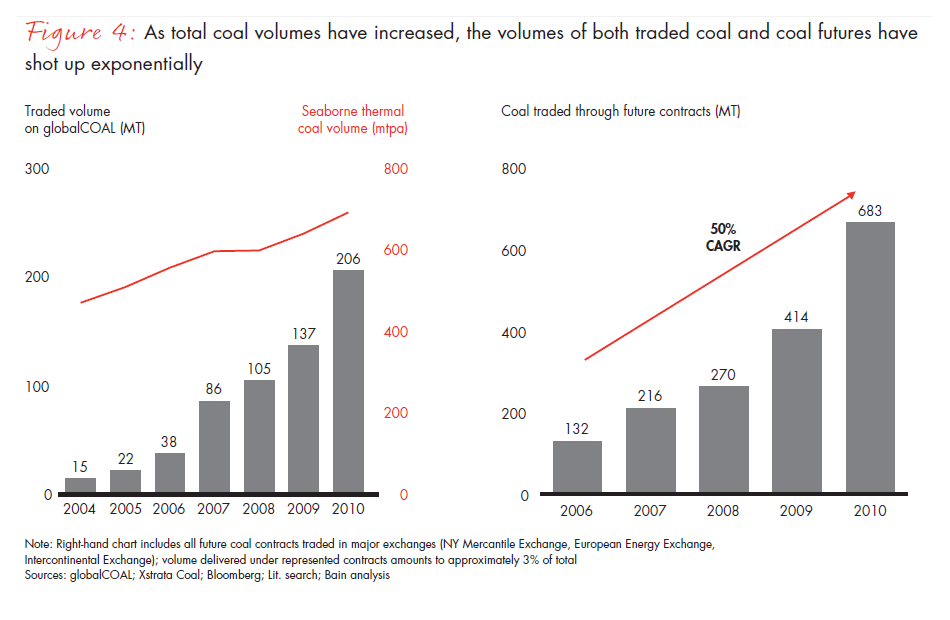
Although short-term trading still accounts for only 15% of LNG volumes, the similarities between the coal and gas markets suggest that an increasingly liquid and vibrant LNG market will emerge, helping to shift Asia increasingly toward gas-on-gas pricing.
New LNG hubs around the world will likely accelerate these trends, and nowhere is this more evident than in Singapore. Due to its geographical advantages, excellent storage infrastructure, attractive tax rates and incentives, sound financial system and existing infrastructure for commodity trading, Singapore is a natural choice for an Asian LNG hub. At least 12 global players, including Gazprom, Shell, BP and BG Group, have established trading desks in Singapore over the past three years. The growth of LNG-focused trading capability is an early indicator of the growing market for spot and short-term LNG contracts, both in Asia-Pacific and globally.
Given a host of factors—the increasing number of LNG players, greater financial liquidity in the global LNG markets, development of conventional gas and the growth of key gas infrastructure such as pipelines—US Henry Hub prices and Asia’s LNG cargo prices are likely to converge over time.
Strategic implications for exploration and production players
The market disruptions caused by shale have shaken up the entire gas value chain. These changes offer rich opportunities for players across the industry—including upstream, midstream and pipeline developers; gas marketers and traders; utilities; and petrochemicals (see Figure 5). Here, we focus on the implications for exploration and production players.
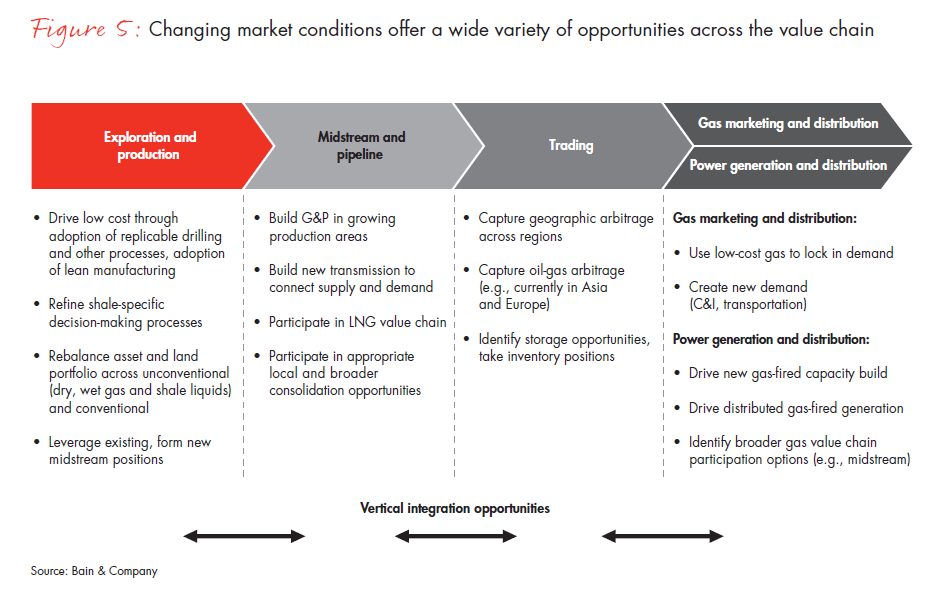
Upstream players should consider multiple strategic actions to improve their positions. They could rebalance their portfolios across several dimensions: geography, the type of gas drilled for (dry versus wet) and the maturity of the assets (producing versus unproven). They could consider expanding across the value chain, including LNG liquefaction and re-gasification, midstream transportation and storage, and trading and marketing opportunities. They could revisit consolidation and other M&A and JV strategies in light of current and future prices of land and assets. Finally, players could also adopt lean manufacturing techniques to lower costs and reduce the risks of their unconventional drilling activities.
Companies are also investing in organic expansion into unconventional gas sources around the world, especially in high-potential countries like Australia and portions of Europe, China and Argentina. As another example of portfolio rebalancing, some companies are shifting their priorities to develop liquid-rich shale since dry gas prices are dropping. Shell and Norway’s Statoil have both recently said they will shift investment from their shale gas properties to focus on liquid-rich shales that contain higher-value liquids, as a hedge against depressed gas prices.
Energy companies can also expand their position across the value chain. As shale production evolves, there will be regional opportunities for new gas and liquids infrastructure in new supply basins and end-use markets. For example, Chesapeake Energy formed two midstream subsidiaries that acquire and develop midstream assets to support its upstream operations. Globally, the recent discoveries of large conventional gas resources in several countries are leading to an expansion of the LNG industry, which is taking share from long-haul pipeline gas. Independent oil companies (IOCs) and national oil companies (NOCs) have a broad set of investment opportunities and choices in LNG liquefaction, shipping and re-gasification.
Currently, many NOCs and IOCs are focused in the upstream, midstream or distribution and marketing portions of the value chain. Several of the IOCs, such as Shell and Chevron, are partially integrated—from exploration and production through LNG liquefaction to re-gasification. Many players are examining and making moves to expand across the value chain from their current positions. Storage can become a value position in the chain, offering the ability to arbitrage across indigenous pipeline and LNG sources in some cases and creating related trading opportunities. Some companies are also exploring downstream moves into gas distribution and marketing. Centrica, for example, with a long heritage of downstream and home energy services in the UK, has made several acquisitions to expand its upstream positions. In North Africa and Italy, Eni is integrated across the region, with operations throughout the entire chain.
The rise of shale gas, the challenges IOCs face accessing new supplies and commodity price movements are all fueling M&A and JV activities and may further accelerate consolidation in some markets. Since the late 2000s, IOCs in the US, for example, have been aggressively acquiring assets and know-how from the independents that largely created the unconventional play. One prominent example is ExxonMobil’s $41 billion takeover of leading unconventional independent XTO Energy in 2009. NOCs have also entered the shale gas market, looking to gain expertise that they can repatriate to their domestic markets and secure access to resources to meet national fuel security agendas. PTT Exploration and Production purchased Statoil’s Canadian oil sands stake for $2.3 billion. Shale gas operators are also partnering for cash and growth: Pioneer Natural Resources formed a JV with Reliance Industries of India, gaining 45% share in the company in exchange for $1.3 billion in cash to finance development in the Eagle Ford basin in 2010.
The low price of gas in the US is another factor that is likely to boost the number of transactions between players with stronger balance sheets and those with less-robust cash positions. Players in this consolidation may include not only NOCs, IOCs and the larger independent E&P players, but private equity players, too. For example, KKR recently invested in shale gas development and prospective acreage. Both E&P and private equity players willing to make those bets will need a positive view of long-term gas market pricing and other risk factors.
E&P players in the US are also looking to reduce their costs in the short term, which for many are greater than Henry Hub prices (see Figure 6). Over the long term, they will need to create more efficient operations to gain competitive advantage. Bain’s analysis of traditional oil and gas drilling, based on EIA data, indicates a 57% cost decrease per barrel with each cumulative doubling of drill well activity. Similar learning-curve benefits are apparent in shale gas extraction, as longer wells, more frac stages per well and more productive wells become the trend. Yet, we are also seeing some diseconomies of scale in shale, where costs become less efficient at much higher levels of drilling, midstream and other activities required to successfully operate in shale. Shale production differs from conventional production in terms of the breadth of highly local activity, the frequency and number of functional handoffs and the extent of drilling, completion, pad and midstream designs. For these reasons, we believe shale production lends itself to approaches that consider the entire value chain, such as Lean Six Sigma, which optimizes end-to-end manufacturing costs, reduces inventory, improves equipment utilization, makes functional handoffs more efficient and reduces overall costs. Talisman Energy and Encana have said they are applying these principles to shale production, and Chevron is bringing them to its oil-field operations.
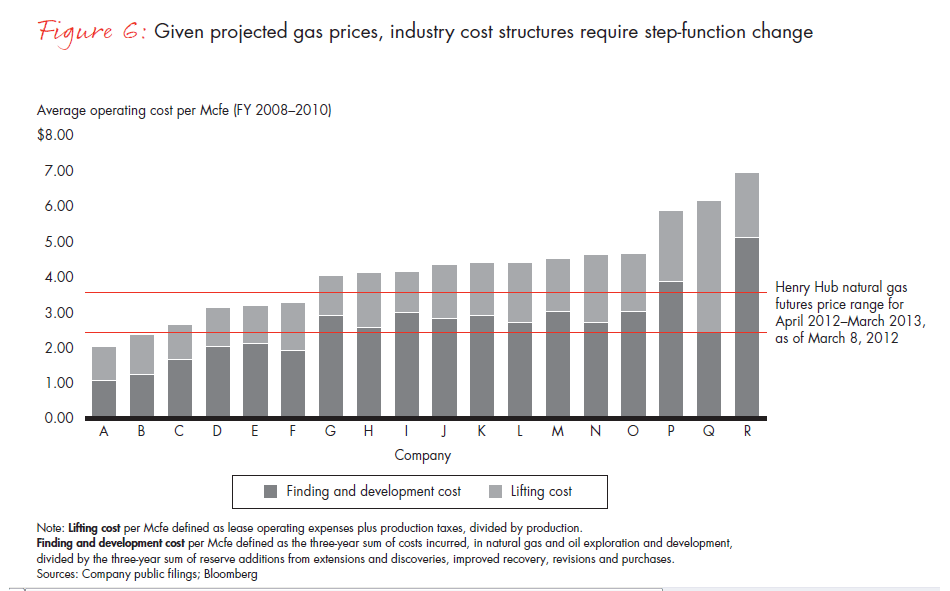
Conclusion
Shale gas is changing the dynamics of the gas world, and with it, the assumptions that underlie many investment strategies. For example, prior investments predicated on a view of gas shortfalls in the US that led to LNG import facilities have since become stranded. The new paradigm of abundant low-cost gas from shale and other sources presents tremendous opportunities across the global upstream value chain. As in all turbulent markets, there will be winners and losers. Gas market changes will affect asset portfolio mix, operational and technology strategies, gas infrastructure investment plans and a multitude of other value chain participation choices. Players that proactively consider the affects of broadly different scenarios and their implications, and adjust their assumptions and strategic plans accordingly, will be better placed to win in this new world.
Julian Critchlow, a Bain partner in the London office, leads the firm’s European Utilities & Alternative Energy practice. Sharad Apte, a partner in the Bangkok office, leads the firm’s Asian Energy practice.





